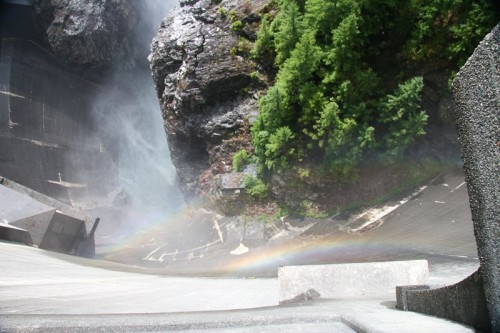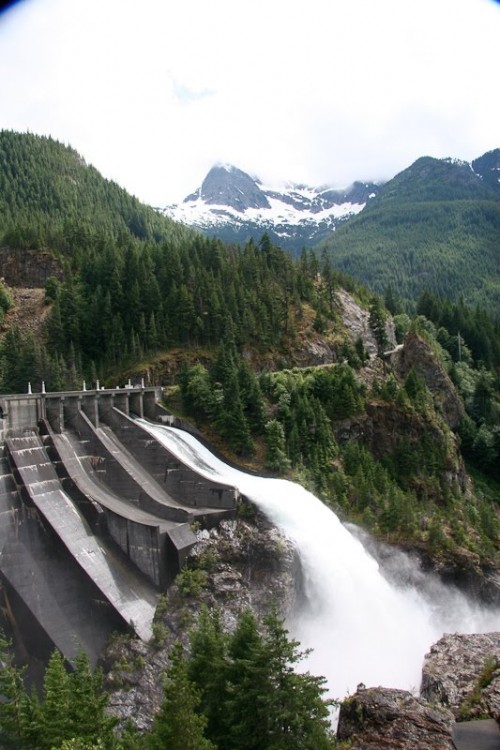The History of Skagit Dams – Seeing Things Anew

By Ana Maria Spagna
I’ve driven Washington’s Highway 20, the North Cascades Highway, for years. I used live in Rockport right along the highway, and I used to work for the national park that straddles the highway, and for one interminable summer when Laurie worked on the east side of the crest and I worked on the west, I commuted over the highway. I’ve been wowed by the mountains and soothed by the rivers, sure, sure. I’ve hiked from trailheads and watched wildlife and even taught writing at North Cascades Institute’s Environmental Learning Center on Diablo Lake. It was there, at the Learning Center, that I first thought seriously about the dams.
To reach the Learning Center you drive right across Diablo Dam. Overhead the power lines buzz. But when writers sat down to describe their surroundings, they usually wrote about birds or fish or trees or clouds. Never the dams. I was as guilty as anyone. The three dams that line the Skagit River, Gorge, Diablo, and Ross, are all more or less visible from the highway, but, in writing as in life, I’d mostly ignored them. Why? I knew the answer: because we nature-loving types have a kneejerk reaction against anything human-made. While we’re in the woods, we want to see the woods. But part of why people come to the Learning Center is to learn about things they know little about, to appreciate them anew. For me, I realized, that meant the dams.
So I was delighted this spring to see that my old friend Jesse Kennedy would teach a class at the Learning Center on the History of the Skagit Dams. Jesse can bring enthusiasm to any subject (you’d have to attend one of his defensive driving classes to believe me) and in this case, the subject could not have been more perfectly suited to him. Dr. Kennedy, who studied both ophthalmology and diesel mechanics extensively before migrating into cultural resources, described dam construction with an engineer’s precision and told the story of J.D. Ross and his battle to bring public power to Seattle with a historian’s heart. Turns out it’s a wild story with several wild subplots. Ross single-handedly fought off proponents of privatization and brought the dams in on schedule and under budget to provide more people in Seattle with more power sooner than in other American cities.
Ross was also a renowned expert on lilies and tea plants, who borrowed monkeys and albino deer from Woodland Park Zoo to place on islands in Diablo Lake. The animals, along with a colorful light show and a hearty chicken meal and a ride up the dramatic cable incline used in dam construction, served as attractions for generations of city folks Ross wooed upriver for inexpensive tours from the Depression through the 1960s. When he died, Franklin Roosevelt offered space in Arlington National Cemetery, but Ross had specified that he’d prefer to lie for eternity along Highway 20 in Newhalem. A plaque at the site quotes Roosevelt who heralded Ross as one of “the greatest Americans of our time,” which is particularly impressive considering that Ross was Canadian.

When at last we visited the dams, we saw a rare sight. The dams, overfull from late snow in the high country, were spilling. The spill would be dramatic in any case, all that water, all that power, but when Jesse turned our attention to the construction, the graceful concrete arc to keep the force of the water from shaking the dam to the ground, my heart swelled the same way it does to see the larches on Liberty Bell backlit in fall. Pure beauty. And this, I realized, was why I’d come. Sometimes it takes a little knowledge to nudge you out of your ideological safety zone, a few good stories, to make you see things anew, to make you think.
These days, I’m thinking a whole lot about reclamation. More on that soon.
Originally published August 10, 2011 on Ana Maria’s blog.

